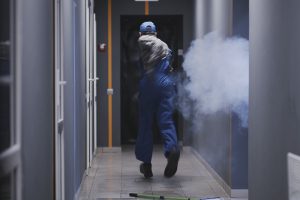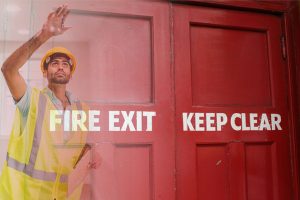By Phil Jones, Managing Director, William Martin

An effective fire safety strategy is essential for every business. Not only does it protect your employees, but it also ensures you remain compliant across the board. Fire stopping should be a key component in every fire strategy—but what is fire stopping?
What is fire stopping?
A firestop is used to help prevent the spread of fire through the different compartments of a building. Often firestops come in the form of sealants, fire-resistant mortar, or rubber compounds. Fire stopping is often used in building construction to seal joints, openings, and gaps to control the movement of flames.
The primary purpose of a firestop is to seal these openings, creating a barrier that withstands the passage of fire and smoke—this is vital for ensuring building safety and compliance.
Is fire stopping a legal requirement?
In many ways—yes.
Many building regulations mandate the use of firestops to ensure that structures adhere to specific safety standards. Compliance with these codes is not only a legal requirement, but also shows a commitment to creating safer environments.
Ever since the incident at Grenfell Tower in 2017, there have been many changes to fire safety regulations. There are also greater penalties for those who are not compliant with the latest regulations. With regards to fire stopping, regulations vary according to building types and size. However, most landlords and building owners will need to put fire stopping measures in place to ensure safety.
There are numerous Acts which denote the use of fire stopping, including The Building Safety Act and The Fire Safety Act 2021. The Fire Safety Act 2021 aims to ensure fire safety for all residential buildings including, but not limited to, high-rises. When it comes to fire safety, regulations are constantly changing. So, it’s crucial that businesses stay up to date on these important changes to remain complaint and avoid legal penalties.
Why is fire stopping important?
 Without correctly installed firestops, smoke and flames can quickly travel, causing devastating damage to the property and risking the lives of its occupants – not to mention the possibility of significant financial penalties for non-compliance.
Without correctly installed firestops, smoke and flames can quickly travel, causing devastating damage to the property and risking the lives of its occupants – not to mention the possibility of significant financial penalties for non-compliance.
Our team of health, safety and fire consultants recently reviewed 3,500 residential fire risk assessments, completed between October 2022 and September 2023. In this research, we found that fire stopping currently accounts for around 20% of recommendations in residential fire risk assessments.
After capturing all the recommendations on our risk management software, Meridian, the team was able to estimate that of the fire stopping recommendations:
- 70% was related to fire stopping that was either missing or poorly maintained.
- 30% was caused by poor workmanship or contractors using unsuitable fire stopping products.
Sub-standard passive fire protection is often discussed in the industry, with numerous examples of poor fire stopping regularly shared on social media. Even the tiniest gap in a fire compartment can render it ineffective. It’s also deeply troubling that we are encountering sub-standard fire stopping in recently constructed buildings, as well as older buildings where contractor works may have damaged structural compartments by running new cables or other services through walls and ceilings.
With so many accounts of ineffective fire stopping, it’s evident that installation and maintenance of firestops play a major role in ensuring health, safety, and compliance. So, what is the solution to implementing effective fire stopping?
How to ensure effective fire stopping
Given the extent of this problem, our advice to ‘Responsible Persons’ would be to carefully consider the following two key points when it comes to meeting their duties relating to general fire precautions and maintenance (as defined by the Regulatory Reform (Fire Safety) Order 2005).
Competence
The Association for Specialist Fire Protection (ASFP) recommends that fire stopping should only be carried out by ‘competent persons’. Ideally, this would those who have had their competency checked by a third-party certification body or a contractor who is certified by a third party.
However, fire stopping can also be completed by other types of contractors who have a secondary function to their main profession. For example, those working as an electrician or a dry-lining contractor. For these contractors, the ASFP recommends they should hold, as a minimum, an NVQ Level 2 qualification in fire stopping.
As well as ensuring contractors are competent, it is also essential to keep a record of all fire stopping work, to enable completion certificates to be issued.
Risk Assessment Planning
 Most residential fire risk assessments are non-destructive and focus on the communal areas. This may include service risers, with a sample of flat doors also being included in the fire risk assessment scope. It is therefore very important for the fire risk assessment visit to be carefully planned, to ensure the ‘Responsible Person’ is sufficiently briefed on the areas where access needs to be arranged for the fire risk assessor.
Most residential fire risk assessments are non-destructive and focus on the communal areas. This may include service risers, with a sample of flat doors also being included in the fire risk assessment scope. It is therefore very important for the fire risk assessment visit to be carefully planned, to ensure the ‘Responsible Person’ is sufficiently briefed on the areas where access needs to be arranged for the fire risk assessor.
By doing this, the assessor stands a much greater chance of identifying sub-standard or missing fire stopping. They will also be able to identify buildings where a more detailed passive fire protection survey is required. Considering that so many firestops are installed incorrectly, thorough risk assessment planning is paramount. Without significant preparation, fire risk assessors could miss crucial details which could be the difference between a fire spreading or being safely contained.
The ‘Responsible Person’ should also focus on record keeping, particularly in the field of fire stopping work. This will help them to comply with new duties around maintaining building fire safety information throughout its life cycle.
Our recent review of residential fire risk assessments serves as a reminder that, despite all the recent changes to fire safety legislation, the ‘Responsible Person’ needs to continually focus on maintaining adequate standards of passive fire protection within the buildings they are responsible for.
Effective fire stopping is not merely a means of staying compliant, it is a fire prevention method used to protect human life and ensure building safety. At William Martin, we provide unparalleled health and safety expertise, as well as powerful technology. With a wealth of industry knowledge, we can give you the support you need to remain strong, compliant, and successful. If you’re committed to ensuring health and safety, get in touch with us today.


